
|
Now it is very bright as 7.9 mag (Sept. 24, Willian Souza). It stays bright as 7 mag until September. In the Northern Hemisphere, it will be observable in excellent condition. It will be getting higher gradually after this also in the Southern Hemisphere.
Date(TT) R.A. (2000) Decl. Delta r Elong. m1 Best Time(A, h)
Sept.29 6 47.41 2 45.2 0.444 1.048 83 7.3 4:15 (224, 42)
Oct. 6 7 1.05 -6 13.3 0.484 1.078 85 7.7 4:04 (231, 50)
|

|
It brightened up to 7.7 mag in June (June 19, Juan Jose Gonzalez). Now it is fading. But it is still bright as 10.2 mag (Oct. 1, Chris Wyatt). It stays bright as 9-10 mag for a while. In the Southern Hemisphere, it stays observable in good condition for a long time until the comet will fade out. In the Northern Hemisphere, it is not observable for a long time until autumn in 2019 when the comet fades out down to 16 mag.
Date(TT) R.A. (2000) Decl. Delta r Elong. m1 Best Time(A, h)
Sept.29 14 26.32 -61 32.3 2.540 2.284 63 9.9 19:26 ( 34, 34)
Oct. 6 14 29.34 -62 42.2 2.621 2.305 60 10.0 19:32 ( 32, 30)
|

|
Now it is 11.2 mag (Oct. 3, Paul Camilleri). It will brighten up to 9 mag until winter. In the Northern Hemisphere, it stays observable in good condition for a long time until it fades out. In the Southern Hemispehre, it is observable in good condition until autumn, but it will be low in winter.
Date(TT) R.A. (2000) Decl. Delta r Elong. m1 Best Time(A, h)
Sept.29 5 50.98 11 35.9 1.220 1.678 97 10.6 4:15 (202, 41)
Oct. 6 6 8.19 12 50.6 1.149 1.652 100 10.3 4:04 (201, 40)
|

|
Now it is bright as 10.9 mag (Oct. 1, Chris Wyatt). It will approach to Earth down to 0.08 a.u. in December, and it is expected to brighten up to 3 mag. In the Northern Hemisphere, it stays observable in excellent condition. In the Southern Hemisphere, it is observable in good condition until mid December when it brightens up to 3 mag. But it becomes unobservable after that.
Date(TT) R.A. (2000) Decl. Delta r Elong. m1 Best Time(A, h)
Sept.29 1 52.90 -25 36.1 0.496 1.434 144 11.5 1:24 (180, 80)
Oct. 6 1 55.61 -27 41.1 0.440 1.378 143 10.8 0:59 (180, 82)
|

|
Outburst occured on Aug. 14. Now it is very bright as 11.4 mag (Oct. 3, Paul Camilleri). It is observable in excellent condition in the Northern Hemisphere. It stays low in the Southern Hemisphere.
Date(TT) R.A. (2000) Decl. Delta r Elong. m1 Best Time(A, h)
Sept.29 0 27.97 30 48.5 0.498 1.458 151 12.0 23:55 (180, 24)
Oct. 6 0 29.99 32 53.4 0.475 1.436 151 11.9 23:30 (180, 22)
|

|
Now it is 12.1 mag (Sept. 5, Thomas Lehmann). It will be fading slowly after this. In the Northern Hemisphere, it stays low until October. But it will be observable in good condition after that. In the Southern Hemisphere, it is not observable until summer in 2019.
Date(TT) R.A. (2000) Decl. Delta r Elong. m1 Best Time(A, h)
Sept.29 12 17.88 47 30.0 3.551 3.002 49 12.0 4:15 (234,-40)
Oct. 6 12 36.06 46 36.8 3.557 3.038 51 12.0 4:04 (235,-40)
|

|
Now it is 12.5 mag (Sept. 21, Paul Camilleri). It stays 12 mag for a long time until spring.
Date(TT) R.A. (2000) Decl. Delta r Elong. m1 Best Time(A, h)
Sept.29 9 0.55 12 23.0 3.283 2.776 51 12.3 4:15 (244, 13)
Oct. 6 9 1.05 10 23.1 3.195 2.797 57 12.3 4:04 (243, 17)
|
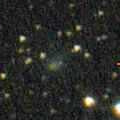
|
It brightened rapidly in outburst up to 6.9 mag (July 19, Maik Meyer). Then it faded down to 9.3 mag (Aug. 2, Katsumi Yoshimoto). It approached to Sun down to 0.2 a.u. in August, and it was expected to brighten up to 3 mag. However, it must have been already disintegrated. Now it is not observable. In the Northern Hemisphere, it will appear in the morning sky in late October. But it will be too faint to observe.
Date(TT) R.A. (2000) Decl. Delta r Elong. m1 Best Time(A, h)
Sept.29 12 7.77 14 55.0 2.116 1.198 17 12.4 4:15 (269,-25)
Oct. 6 12 21.04 16 15.4 2.209 1.336 22 13.0 4:04 (267,-25)
|
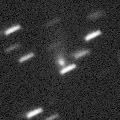
|
It brightened up to 8.7 mag in July (July 18, Marco Goiato). Now it is fading. But it is still bright as 12.3 mag (Aug. 29, Chris Wyatt). It will be unobservable soon even in the Southern Hemisphere. In the Northern Hemisphere, it is not observable until late December.
Date(TT) R.A. (2000) Decl. Delta r Elong. m1 Best Time(A, h)
Sept.29 13 24.84 -28 41.8 2.285 1.512 30 12.6 19:26 ( 62, 10)
Oct. 6 13 44.27 -27 58.6 2.432 1.605 26 13.0 19:32 ( 61, 7)
|

|
Outburst occured on Sept. 20. Now it is bright as 11.6 mag (Oct. 1, Paul Camilleri).
Date(TT) R.A. (2000) Decl. Delta r Elong. m1 Best Time(A, h)
Sept.29 22 53.21 0 1.9 4.830 5.772 158 13.1 22:20 (180, 55)
Oct. 6 22 50.66 -0 13.0 4.878 5.771 150 13.2 21:50 (180, 55)
|

|
Now it is bright as 12.6 mag (Oct. 3, Paul Camilleri). It stays at 12-13 mag from summer to autumn. It is observable in excellent condition in the Southern Hemisphere. It locates somewhat low in the Northern Hemisphere.
Date(TT) R.A. (2000) Decl. Delta r Elong. m1 Best Time(A, h)
Sept.29 22 28.13 -28 43.7 1.175 2.040 139 13.2 21:56 (180, 84)
Oct. 6 22 29.10 -28 24.7 1.233 2.051 133 13.4 21:29 (180, 83)
|

|
It approached to Earth down to 0.3 a.u., and brightened up to 8.3 mag in July (July 22, Juan Jose Gonzalez). Now it is fading. But it is still bright as 12.9 mag (Sept. 8, Chris Wyatt). It will be unobservable in October.
Date(TT) R.A. (2000) Decl. Delta r Elong. m1 Best Time(A, h)
Sept.29 15 7.13 -7 17.4 2.159 1.563 41 13.6 19:26 ( 94, 18)
Oct. 6 15 8.24 -6 57.1 2.326 1.620 35 13.9 19:32 ( 89, 11)
|
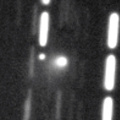
|
Now it is 13.9 mag (Sept. 3, Paul Camilleri). It stays at 14-15 mag for a long time from summer to winter. In the Southern Hemisphere, it will be getting lower rapidly after this, then it becomes unobservable after October. In the Northern Hemisphere, it stays observable for a long time until it fades out. But it stays extremely low.
Date(TT) R.A. (2000) Decl. Delta r Elong. m1 Best Time(A, h)
Sept.29 15 18.68 -4 32.3 2.486 1.906 44 13.8 19:26 ( 98, 19)
Oct. 6 15 30.65 -3 14.0 2.502 1.868 41 13.7 19:32 ( 96, 14)
|

|
It brightens up to 13 mag in October. But it is not observable at all.
Date(TT) R.A. (2000) Decl. Delta r Elong. m1 Best Time(A, h)
Sept.29 13 8.29 -7 28.0 2.035 1.083 13 14.6 19:26 ( 77, -5)
Oct. 6 13 37.26 -8 37.4 2.032 1.084 13 13.8 19:32 ( 75, -6)
|
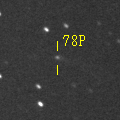
|
Now it is 13.5 mag (Sept. 29, Piotr Guzik). It stays at 12-13 mag for a long time from winter to autumn in 2019. It stays observable in good condition until winter when the comet brightens up to 12-13 mag.
Date(TT) R.A. (2000) Decl. Delta r Elong. m1 Best Time(A, h)
Sept.29 21 20.01 -7 44.0 1.686 2.488 133 14.0 20:48 (180, 63)
Oct. 6 21 19.68 -8 12.9 1.724 2.459 126 13.9 20:20 (180, 63)
|
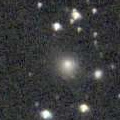
|
Now it is 14.0 mag (Sept. 6, Paul Camilleri). It stays 13-14 mag until summer in 2019. In the Northern Hemisphere, it stays observable in good condition for a while. It locates somewhat low in the Southern Hemisphere.
Date(TT) R.A. (2000) Decl. Delta r Elong. m1 Best Time(A, h)
Sept.29 16 19.30 11 22.5 3.793 3.419 60 14.2 19:26 (121, 21)
Oct. 6 16 21.01 9 10.7 3.865 3.400 55 14.3 19:32 (114, 16)
|

|
Now it is 14.3 mag (Aug. 17, Ken-ichi Kadota). It will be observable at 13-14 mag for a long time from 2017 to 2018. In the Southern Hemisphere, it will be hardly observable after this. It becomes extremely low in September also in the Northern Hemisphere.
Date(TT) R.A. (2000) Decl. Delta r Elong. m1 Best Time(A, h)
Sept.29 11 54.99 35 27.9 4.953 4.211 38 14.3 4:15 (247,-32)
Oct. 6 11 56.70 35 5.5 4.934 4.239 41 14.4 4:04 (246,-29)
|

|
Now it is 14.2 mag (Sept. 17, Seiichi Yoshida). It will brighten up to 14 mag in winter. It will be observable in excellent condition in the Northern Hemisphere. In the Southern Hemisphere, it is not observable until summer in 2019.
Date(TT) R.A. (2000) Decl. Delta r Elong. m1 Best Time(A, h)
Sept.29 6 11.61 57 35.9 1.640 1.967 93 14.7 4:15 (192, -4)
Oct. 6 6 36.12 60 48.5 1.591 1.958 95 14.6 4:04 (191, -8)
|

|
Now it is 14.5 mag (Aug. 16, P. Camilleri, H. Williams). It stays 15 mag from 2018 to 2019, and it will be observable for a long time in the Southern Hemisphere. In the Northern Hemisphere, it will never be observable again.
Date(TT) R.A. (2000) Decl. Delta r Elong. m1 Best Time(A, h)
Sept.29 14 16.61 -66 33.1 4.349 4.072 67 15.0 19:26 ( 28, 34)
Oct. 6 14 36.13 -67 1.5 4.377 4.056 64 15.0 19:32 ( 27, 32)
|

|
Now it is 13.8 mag (Oct. 3, Paul Camilleri). It will brighten up to 12 mag in autumn in 2019. It stays observable in good condition for a while in the Southern Hemisphere. In the Northern Hemisphere, it stays extremely low for a long time.
Date(TT) R.A. (2000) Decl. Delta r Elong. m1 Best Time(A, h)
Sept.29 2 44.57 -46 52.8 4.306 4.906 121 15.1 2:15 ( 0, 78)
Oct. 6 2 36.02 -47 8.6 4.248 4.860 122 15.0 1:39 ( 0, 78)
|
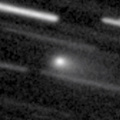
|
It brightened up to 12 mag from spring to summer. Now it is fading. But it is bright as 14.1 mag still now (Sept. 7, Thomas Lehmann).
Date(TT) R.A. (2000) Decl. Delta r Elong. m1 Best Time(A, h)
Sept.29 23 0.96 5 44.6 1.157 2.126 159 15.7 22:28 (180, 49)
Oct. 6 22 57.51 5 25.5 1.226 2.165 153 16.0 21:57 (180, 49)
|

|
It brightened up to 7.1 mag from May to June in 2017 (June 21, Juan Jose Gonzalez). Now it is fading. It has already faded down to 16.6 mag (Sept. 3, Slooh.com Chile Observatory, La Dehesa). In the Southern Hemisphere, it stays observable for a long time after this. It will never be observable again in the Northern Hemisphere.
Date(TT) R.A. (2000) Decl. Delta r Elong. m1 Best Time(A, h)
Sept.29 1 38.32 -54 44.1 4.933 5.514 120 16.1 1:09 ( 0, 70)
Oct. 6 1 31.56 -54 50.5 5.014 5.575 119 16.2 0:35 ( 0, 70)
|

|
Now it is 17.3 mag (Sept. 14, A. Diepvens). It will brighten up to 13-14 mag in winter, and it will be observable in excellent condition.
Date(TT) R.A. (2000) Decl. Delta r Elong. m1 Best Time(A, h)
Sept.29 8 41.25 29 59.8 2.660 2.350 61 16.3 4:15 (228, 4)
Oct. 6 8 56.14 29 41.5 2.569 2.328 64 16.2 4:04 (228, 5)
|

|
Now it is 16.2 mag (Sept. 16, Mt. Lemmon Survey). It is observable in good condition in the Southern Hemisphere. It locates somewhat low in the Northern Hemisphere.
Date(TT) R.A. (2000) Decl. Delta r Elong. m1 Best Time(A, h)
Sept.29 22 55.12 -20 12.0 2.447 3.348 149 16.2 22:22 (180, 75)
Oct. 6 22 51.75 -20 9.7 2.515 3.363 142 16.3 21:51 (180, 75)
|
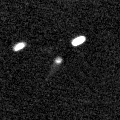
|
It will brighten up to 15 mag in winter. It is observable in excellent condition in the Northern Hemisphere. It is not observable at all in the Southern Hemisphere.
Date(TT) R.A. (2000) Decl. Delta r Elong. m1 Best Time(A, h)
Sept.29 11 0.82 37 52.2 4.073 3.426 44 16.4 4:15 (239,-23)
Oct. 6 11 4.51 38 43.6 3.970 3.407 49 16.3 4:04 (237,-22)
|
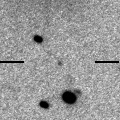
|
Now it is 16.7 mag (Sept. 19, ATLAS-MLO, Mauna Loa). It is expected to brighten up to 7-8 mag in 2020. In 2018, it will be observable at 15-16 mag in good condition from autum to winter.
Date(TT) R.A. (2000) Decl. Delta r Elong. m1 Best Time(A, h)
Sept.29 3 59.28 -5 0.1 5.830 6.455 124 16.4 3:30 (180, 60)
Oct. 6 3 57.11 -5 14.3 5.694 6.397 131 16.3 3:00 (180, 60)
|
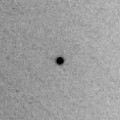
|
Now it is 16.2 mag (June 17, Jean-Francois Soulier). It stays 16 mag for a while. In the Northern Hemisphere, it stays observable in good condition after this until it fades out. It will be unobservable soon in the Southern Hemisphere. Its cometary activity was observed on Mar. 26 (M. Mommert, D. Polishook, N. Moskovitz).
Date(TT) R.A. (2000) Decl. Delta r Elong. m1 Best Time(A, h)
Sept.29 2 37.69 51 48.5 1.401 2.118 122 16.5 2:09 (180, 3)
Oct. 6 2 24.76 53 14.5 1.417 2.176 127 16.5 1:29 (180, 2)
|
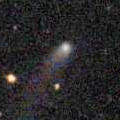
|
It brightened up to 14.7 mag in early 2018 (Jan. 25, Catalina Sky Survey). Now it is fading slowly. Now it is 16.5 mag (Sept. 16, Kunihiro Shima). In the Northern Hemisphere, it stays observable in good condition for a long time until the comet fades out. It is never observable again in the Southern Hemisphere.
Date(TT) R.A. (2000) Decl. Delta r Elong. m1 Best Time(A, h)
Sept.29 8 22.28 55 22.8 5.975 5.800 75 16.5 4:15 (208,-12)
Oct. 6 8 24.01 56 34.0 5.893 5.820 80 16.5 4:04 (206,-11)
|

|
Now it is 16.9 mag (Sept. 12, D. Buczynski). It stays 16-17 mag for a long time until 2020. It is observable in good condition in the Northern Hemisphere. It is not observable at all in the Southern Hemisphere.
Date(TT) R.A. (2000) Decl. Delta r Elong. m1 Best Time(A, h)
Sept.29 10 28.68 67 21.3 8.744 8.492 72 16.9 4:15 (207,-30)
Oct. 6 10 38.49 67 23.8 8.679 8.488 75 16.8 4:04 (206,-30)
|
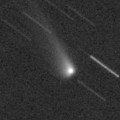
|
Now it is 16.4 mag (Sept. 18, ATLAS-MLO, Mauna Loa). Fading now. It stays observable in good condition for a long time after this in the Southern Hemisphere. It stays low in the Northern Hemisphere.
Date(TT) R.A. (2000) Decl. Delta r Elong. m1 Best Time(A, h)
Sept.29 23 33.43 -36 43.9 4.064 4.870 139 16.9 23:00 ( 0, 88)
Oct. 6 23 23.47 -37 44.4 4.158 4.898 133 16.9 22:23 ( 0, 87)
|
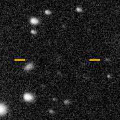
|
Now it is 17.1 mag (Sept. 16, Ken-ichi Kadota). It is observable at 16.5 mag in good condition from autumn to winter. It locates somewhat low in the Southern Hemisphere.
Date(TT) R.A. (2000) Decl. Delta r Elong. m1 Best Time(A, h)
Sept.29 7 28.74 28 49.3 2.390 2.361 76 17.0 4:15 (217, 15)
Oct. 6 7 40.42 28 22.6 2.314 2.363 80 16.9 4:04 (216, 16)
|
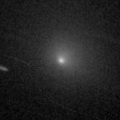
|
It brightened rapidly, and brightened up to 10.2 mag from May to June (May 22, Chris Wyatt). Now it is fading. It has already faded down to 16.9 mag (Sept. 16, ATLAS-HKO, Haleakala). It stays observable in good condition for a long time after this. But it will be fainter than 18 mag in October.
Date(TT) R.A. (2000) Decl. Delta r Elong. m1 Best Time(A, h)
Sept.29 0 22.18 -10 26.4 1.116 2.105 167 16.9 23:49 (180, 65)
Oct. 6 0 13.39 -9 32.0 1.189 2.167 163 17.5 23:12 (180, 64)
|

|
Asteroid, but it brightened rapidly. Now it is 16.8 mag (Aug. 16, Slooh.com Chile Observatory, La Dehesa).
Date(TT) R.A. (2000) Decl. Delta r Elong. m1 Best Time(A, h)
Sept.29 23 4.49 -46 16.5 6.161 6.832 128 17.0 22:31 ( 0, 79)
Oct. 6 22 55.73 -46 19.1 6.217 6.816 123 17.0 21:55 ( 0, 79)
|

|
Now it is 16.5 mag (Sept. 17, J. Nicolas, C. Rinner, F. Kugel, A. Klotz). It will be observable at 16.5 mag in good condition from August to September.
Date(TT) R.A. (2000) Decl. Delta r Elong. m1 Best Time(A, h)
Sept.29 21 22.01 -7 14.3 1.223 2.053 134 17.0 20:50 (180, 62)
Oct. 6 21 24.18 -7 29.9 1.256 2.032 128 17.1 20:25 (180, 62)
|

|
First return of a new periodic comet which brightened up to 16.5 mag in 2005. Now it is 17.3 mag (Sept. 15, A. Martin, K. Kleemann-Boeker). It will be observable at 17 mag in good condition in autumn. It locates low in the Southern Hemisphere.
Date(TT) R.A. (2000) Decl. Delta r Elong. m1 Best Time(A, h)
Sept.29 1 58.95 35 43.8 1.206 2.072 139 17.1 1:30 (180, 19)
Oct. 6 1 58.40 35 25.2 1.177 2.078 145 17.0 1:02 (180, 19)
|

|
First return of a new periodic comet which brightened up to 17.5 mag in 2010. Now it is 18.1 mag (Sept. 9, Mt. Lemmon Survey). It is expected to brighten up to 16.5 mag from November to December. It is observable in excellent condition in the Northern Hemisphere. It locates low in the Southern Hemisphere.
Date(TT) R.A. (2000) Decl. Delta r Elong. m1 Best Time(A, h)
Sept.29 5 29.96 24 41.2 1.487 1.963 102 17.3 4:15 (192, 29)
Oct. 6 5 40.52 25 37.3 1.420 1.959 106 17.2 4:04 (190, 29)
|

|
Now it is 18.0 mag (Sept. 10, iTelescope Observatory, Mayhill). It is observable at 17 mag in good condition in winter. It locates low in the Southern Hemisphere.
Date(TT) R.A. (2000) Decl. Delta r Elong. m1 Best Time(A, h)
Sept.29 9 16.86 21 35.0 2.512 2.032 50 17.3 4:15 (240, 4)
Oct. 6 9 31.29 21 14.2 2.484 2.067 54 17.3 4:04 (240, 5)
|

|
Now it is 16.8 mag (Sept. 14, A. Diepvens). It will be fading gradually after this, and it will be fainter than 18 mag in winter. In the Northern Hemisphere, it stays observable in good condition for a long time. In the Southern Hemisphere, it will never be observable again.
Date(TT) R.A. (2000) Decl. Delta r Elong. m1 Best Time(A, h)
Sept.29 22 50.15 76 49.6 7.350 7.660 104 17.3 22:17 (180,-22)
Oct. 6 22 44.75 76 16.2 7.339 7.687 106 17.3 21:44 (180,-21)
|
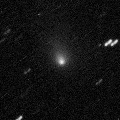
|
It brightened very rapidly up to 13.8 mag in last August (Aug. 22, 2017, Kunihiro Shima). Now it is 16.8 mag (Aug. 18, Slooh.com Canary Islands Observatory). In the Northern Hemisphere, it stays observable in excellent condition after this. It will be observable also in the Southern Hemisphere in December, but it stays low.
Date(TT) R.A. (2000) Decl. Delta r Elong. m1 Best Time(A, h)
Sept.29 9 17.67 28 51.3 2.831 2.378 53 17.3 4:15 (235, -1)
Oct. 6 9 31.48 28 47.6 2.785 2.402 57 17.3 4:04 (234, 0)
|

|
Now it is 17.3 mag (Sept. 18, Catalina Sky Survey). It will brighten very rapidly after this. It will brighten up to 14.5 mag from January to February, and it is expected to be observable in excellent condition.
Date(TT) R.A. (2000) Decl. Delta r Elong. m1 Best Time(A, h)
Sept.29 7 49.94 21 17.8 1.843 1.773 70 17.6 4:15 (225, 19)
Oct. 6 8 8.61 20 12.1 1.765 1.747 72 17.3 4:04 (226, 19)
|

|
It brightened rapidly up to 11.1 mag (July 13, Chris Wyatt). Now it is fading. It has already faded down to 16.4 mag (Sept. 16, Kunihiro Shima). It will be fainter than 18 mag in October.
Date(TT) R.A. (2000) Decl. Delta r Elong. m1 Best Time(A, h)
Sept.29 0 5.84 -23 55.7 0.644 1.604 153 17.4 23:32 (180, 79)
Oct. 6 23 55.15 -21 46.8 0.732 1.677 150 17.8 22:54 (180, 77)
|
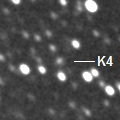
|
Now it is 16.8 mag (Sept. 11, D. Buczynski). It was observed at 16 mag from summer to autumn in 2017. It will be observable at 17 mag in good condition also in 2018. It locates somewhat low in the Southern Hemisphere.
Date(TT) R.A. (2000) Decl. Delta r Elong. m1 Best Time(A, h)
Sept.29 0 55.54 30 0.7 2.774 3.683 150 17.4 0:27 (180, 25)
Oct. 6 0 51.18 29 45.6 2.796 3.727 155 17.5 23:50 (180, 25)
|

|
It was observed at 17 mag in last winter. It will be observable in good condition at 17.5 mag also in this winter.
Date(TT) R.A. (2000) Decl. Delta r Elong. m1 Best Time(A, h)
Sept.29 5 45.92 10 0.6 7.766 7.982 98 17.5 4:15 (201, 43)
Oct. 6 5 43.53 9 33.9 7.652 7.987 106 17.5 4:04 (195, 44)
|

|
It brightened very rapidly. Now it is 17.3 mag (Sept. 16, Mt. Lemmon Survey). It will be fading after October.
Date(TT) R.A. (2000) Decl. Delta r Elong. m1 Best Time(A, h)
Sept.29 0 2.46 -18 40.1 0.787 1.759 158 17.5 23:29 (180, 74)
Oct. 6 23 58.30 -18 0.8 0.802 1.757 154 17.5 22:58 (180, 73)
|

|
Return of a new periodic comet which brightened up to 17 mag in 2001. It was missed at the last return in 2010. Now it is 19.1 mag (Sept. 8, E. Schwab, D. Abreu). It was predicted to brighten up to 17.5 mag from September to November. But actually, it is a bit fainter than predicted.
Date(TT) R.A. (2000) Decl. Delta r Elong. m1 Best Time(A, h)
Sept.29 2 2.67 -13 49.2 1.266 2.192 150 17.5 1:34 (180, 69)
Oct. 6 1 58.15 -13 41.6 1.247 2.191 154 17.5 1:02 (180, 69)
|

|
Now it is 19.7 mag (Sept. 18, R. Fichtl). It will brighten rapidly. It is expected to be observable at 15.5 mag in good condition in winter.
Date(TT) R.A. (2000) Decl. Delta r Elong. m1 Best Time(A, h)
Sept.29 4 45.07 -6 38.7 1.393 2.013 113 17.8 4:15 (180, 62)
Oct. 6 4 51.15 -7 2.0 1.313 1.985 117 17.5 3:54 (180, 62)
|

|
Now it is 17.6 mag (Sept. 13, iTelescope Observatory, Mayhill). It was observed at 18 mag in last winter. It will be observable in good condition at 17.5 mag also in this winter.
Date(TT) R.A. (2000) Decl. Delta r Elong. m1 Best Time(A, h)
Sept.29 6 58.85 10 26.1 2.825 2.845 80 17.8 4:15 (221, 35)
Oct. 6 7 5.87 9 38.4 2.747 2.855 85 17.8 4:04 (219, 37)
|

|
Now it is 17.8 mag (Aug. 23, iTelescope Observatory, Siding Spring). It stays 17 mag in 2018.
Date(TT) R.A. (2000) Decl. Delta r Elong. m1 Best Time(A, h)
Sept.29 5 14.09 3 30.9 7.297 7.645 106 17.8 4:15 (192, 51)
Oct. 6 5 14.12 3 12.8 7.232 7.679 113 17.8 4:04 (185, 52)
|
|
![]()
 46P/Wirtanen
46P/Wirtanen 64P/Swift-Gehrels
64P/Swift-Gehrels C/2016 R2 ( PanSTARRS )
C/2016 R2 ( PanSTARRS ) C/2016 N6 ( PanSTARRS )
C/2016 N6 ( PanSTARRS ) C/2017 S3 ( PanSTARRS )
C/2017 S3 ( PanSTARRS ) C/2017 T3 ( ATLAS )
C/2017 T3 ( ATLAS ) 29P/Schwassmann-Wachmann 1
29P/Schwassmann-Wachmann 1 48P/Johnson
48P/Johnson C/2018 N1 ( NEOWISE )
C/2018 N1 ( NEOWISE ) C/2018 L2 ( ATLAS )
C/2018 L2 ( ATLAS ) 26P/Grigg-Skjellerup
26P/Grigg-Skjellerup 78P/Gehrels 2
78P/Gehrels 2 C/2017 M4 ( ATLAS )
C/2017 M4 ( ATLAS ) C/2015 O1 ( PanSTARRS )
C/2015 O1 ( PanSTARRS ) (944) Hidalgo
(944) Hidalgo C/2017 B3 ( LINEAR )
C/2017 B3 ( LINEAR ) C/2018 N2 ( ASASSN )
C/2018 N2 ( ASASSN ) 37P/Forbes
37P/Forbes C/2015 V2 ( Johnson )
C/2015 V2 ( Johnson ) 123P/West-Hartley
123P/West-Hartley 65P/Gunn
65P/Gunn C/2018 A3 ( ATLAS )
C/2018 A3 ( ATLAS ) C/2017 T2 ( PanSTARRS )
C/2017 T2 ( PanSTARRS ) (3552) Don Quixote
(3552) Don Quixote C/2016 A1 ( PanSTARRS )
C/2016 A1 ( PanSTARRS ) C/2010 U3 ( Boattini )
C/2010 U3 ( Boattini ) C/2015 V1 ( PanSTARRS )
C/2015 V1 ( PanSTARRS ) 59P/Kearns-Kwee
59P/Kearns-Kwee 66P/du Toit
66P/du Toit A/2017 U7
A/2017 U7 137P/Shoemaker-Levy 2
137P/Shoemaker-Levy 2 P/2018 L3 ( NEAT )
P/2018 L3 ( NEAT ) P/2018 P1 ( Hill )
P/2018 P1 ( Hill ) 164P/Christensen
164P/Christensen C/2014 OE4 ( PanSTARRS )
C/2014 OE4 ( PanSTARRS ) 240P/NEAT
240P/NEAT 60P/Tsuchinshan 2
60P/Tsuchinshan 2 364P/2018 A2 ( PanSTARRS )
364P/2018 A2 ( PanSTARRS ) C/2017 K4 ( ATLAS )
C/2017 K4 ( ATLAS ) C/2015 XY1 ( Lemmon )
C/2015 XY1 ( Lemmon ) P/2018 P3 ( PanSTARRS )
P/2018 P3 ( PanSTARRS ) P/2018 R1 ( LINEAR-Skiff )
P/2018 R1 ( LINEAR-Skiff ) 171P/Spahr
171P/Spahr 361P/2017 S4 ( Spacewatch )
361P/2017 S4 ( Spacewatch ) C/2011 KP36 ( Spacewatch )
C/2011 KP36 ( Spacewatch )![]()
































